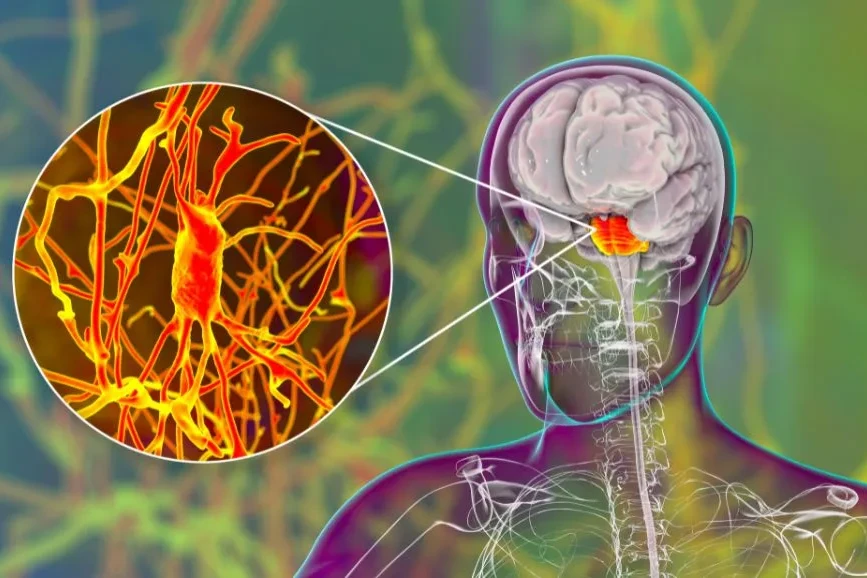If you or someone you know has been experiencing unsteadiness, difficulty walking, and other motor impairments, it’s crucial to be aware of the potential signs of Friedreich’s ataxia. This genetic disorder, also known as FRDA, is a progressive neurodegenerative condition that typically develops during adolescence.
Friedreich’s ataxia symptoms may manifest as an unsteady posture, frequent falling, and progressive difficulty in walking due to impaired coordination of voluntary movements. Other common symptoms include slurred speech, foot deformities, an irregular curvature of the spine, and the presence of cardiomyopathy and diabetes in some cases.
Monitoring your health and recognizing the early signs of Friedreich’s ataxia can lead to timely intervention and improved management of the condition. Understanding the symptoms is crucial for individuals who may be at risk or have a family history of this genetic disorder.
Table of Contents
TogglePrimary Symptoms of Friedreich’s Ataxia
Friedreich’s ataxia is characterized by several primary symptoms that affect motor function and coordination. These symptoms progressively worsen over time and can significantly impact an individual’s quality of life.
The main symptom of Friedreich’s ataxia is progressive ataxia, which refers to the loss of muscle coordination. This primarily affects the limbs, especially during walking. People with Friedreich’s ataxia experience an unsteady gait and have difficulty maintaining balance. The impairment in muscle coordination also leads to poor control of fine movements in the limbs, making tasks such as writing or handling objects challenging.
Another symptom commonly associated with Friedreich’s ataxia is impaired swallowing. This can result in difficulties in eating and drinking, requiring careful monitoring and modifications to the diet. Additionally, individuals may develop slurred speech (dysarthria) as the disease progresses, affecting their ability to communicate clearly.
Loss of reflexes is also observed in individuals with Friedreich’s ataxia. This means that certain automatic responses that normally occur in response to stimuli, such as the knee-jerk reflex, may be absent or reduced. Though this symptom can vary among individuals, it is essential to note that intellect is usually unaffected in individuals with Friedreich’s ataxia, as it primarily affects physical coordination and motor function.

Atypical Presentations of Friedreich’s Ataxia
If you think Friedreich’s ataxia only affects individuals in their teenage years, think again. While most people are diagnosed before the age of 25, there are instances where the disease presents later in life. Late-onset Friedreich’s ataxia (LOFA) and very late-onset Friedreich’s ataxia (VLOFA) are two atypical forms of the condition that affect approximately 15% of individuals with Friedreich’s ataxia.
LOFA is characterized by an age of onset between 26 and 39 years, while VLOFA typically presents after the age of 40 years. Compared to typical Friedreich’s ataxia cases, individuals with LOFA and VLOFA experience a slower disease progression.
Understanding Late-onset Friedreich’s Ataxia (LOFA)
LOFA is a form of Friedreich’s ataxia that manifests between the ages of 26 and 39. Despite the later onset, individuals with LOFA still experience similar symptoms to those with the typical form of the condition. However, the progression of the disease tends to be slower, allowing individuals to retain certain motor functions for a longer period of time.
Exploring Very Late-onset Friedreich’s Ataxia (VLOFA)
VLOFA is a rare variant of Friedreich’s ataxia that occurs after the age of 40. Individuals with VLOFA may experience milder symptoms compared to those with typical Friedreich’s ataxia. Similar to LOFA, the disease progression in VLOFA is slower, giving individuals more time before significant motor impairments occur.
While late-onset and very late-onset Friedreich’s ataxia are rare, it is important to be aware of their existence. If you or a loved one are experiencing symptoms of Friedreich’s ataxia later in life, consult a healthcare professional for proper evaluation and diagnosis.
Causes of Friedreich’s Ataxia
Friedreich’s ataxia is a genetic condition that is caused by pathogenic variants in the FXN gene. The FXN gene plays a crucial role in the production of frataxin, a protein that is necessary for proper mitochondrial functioning. In individuals with Friedreich’s ataxia, both copies of the FXN gene are abnormal, leading to a reduced production of frataxin.
This deficiency in frataxin production has a detrimental effect on various tissues, particularly on nerve and heart cells. The lack of frataxin causes degeneration in these cells, contributing to the development of symptoms associated with Friedreich’s ataxia.
The majority of individuals with Friedreich’s ataxia have an expanded GAA trinucleotide repeat in both copies of the FXN gene. This expansion leads to gene silencing and a significant reduction in frataxin production.
Friedreich’s Ataxia Genetics
Friedreich’s ataxia follows an autosomal recessive pattern of inheritance, which means that an individual must inherit two copies of the abnormal FXN gene, one from each parent, to develop the condition. If only one copy of the FXN gene is abnormal, the individual is considered a carrier and does not typically experience symptoms.
| Genotype | Phenotype |
|---|---|
| Normal FXN gene | No symptoms, not a carrier |
| One normal FXN gene and one abnormal FXN gene | Carrier, no symptoms |
| Two abnormal FXN genes | Develops Friedreich’s ataxia |
It is important to note that the severity of Friedreich’s ataxia symptoms can vary among individuals, even those who carry the same genetic mutations. Other genetic and environmental factors may contribute to this variability, and ongoing research aims to better understand these influences.
Understanding the underlying genetic cause of Friedreich’s ataxia is key to developing targeted therapies and interventions. Research efforts continue to focus on unraveling the complex mechanisms of this genetic condition, with the aim of improving the quality of life for individuals affected by Friedreich’s ataxia.
Affected Populations of Friedreich’s Ataxia
Friedreich’s ataxia is a relatively rare disorder, affecting approximately 1 in 40,000 people. While it may be considered a rare condition, it can have a significant impact on the lives of those affected. Friedreich’s ataxia is most commonly observed in populations of European, Middle Eastern, South Asian (Indian subcontinent), and North African descent, although it can occur in other populations as well.
Prevalence of Friedreich’s Ataxia
To better understand the prevalence of Friedreich’s ataxia, let’s take a closer look at various regions:
| Region | Prevalence |
|---|---|
| Europe | Higher prevalence compared to other regions |
| Middle East | Significant presence in the population |
| South Asia (Indian subcontinent) | Relatively common occurrence |
| North Africa | Notable prevalence in the population |
These regions have a higher incidence of Friedreich’s ataxia due to genetic factors and shared ancestry. However, it is important to note that the disorder can still occur in individuals from other backgrounds.
Diagnosis of Friedreich’s Ataxia
The diagnosis of Friedreich’s ataxia involves a comprehensive evaluation that encompasses medical history, physical examination, and genetic testing. By considering these factors together, healthcare providers can accurately diagnose the condition and formulate an appropriate treatment plan.
Medical History
When assessing a patient suspected of having Friedreich’s ataxia, the healthcare provider will obtain a detailed medical history. This includes collecting information about the patient’s symptoms, their progression over time, and any associated medical conditions or family history of the disease. A thorough understanding of the patient’s medical background helps to provide valuable insights into the diagnosis process.
Physical Examination
During the physical examination, the healthcare provider will carefully assess various aspects of the patient’s neurological function. This may involve evaluating reflexes, balance, muscle strength, and coordination. Additionally, the provider may perform tests to assess sensory function, such as nerve sensation. By conducting a comprehensive physical examination, the healthcare provider can gather essential clinical information that can aid in the diagnosis of Friedreich’s ataxia.
Genetic Testing
Genetic testing is a crucial component of the diagnostic process for Friedreich’s ataxia. It involves analyzing the patient’s DNA to identify any pathogenic variants in the FXN gene, which is associated with this condition. By detecting the presence of these variants, genetic testing confirms the diagnosis of Friedreich’s ataxia. It also helps to distinguish the condition from other disorders that may present with similar symptoms.
Additional Diagnostic Tests
In some cases, healthcare providers may utilize additional diagnostic tests to further support the diagnosis of Friedreich’s ataxia. These tests may include blood tests to assess specific biomarkers, imaging scans such as magnetic resonance imaging (MRI) or computed tomography (CT) scans to evaluate the structure of the brain, nerve conduction studies to assess nerve function, and heart tests to evaluate any associated cardiac abnormalities.

Genetic testing is crucial for identifying the pathogenic variants in the FXN gene and confirming the diagnosis of Friedreich’s ataxia.
Treatment of Friedreich’s Ataxia
While there is no cure for Friedreich’s ataxia, there are several treatment options available to help manage symptoms and improve quality of life. A multidisciplinary approach that involves continuous medical supervision is recommended to address the complex nature of this condition and its impact on various organ systems.
One of the key components of treatment for Friedreich’s ataxia is symptomatic management. This involves addressing specific symptoms and providing supportive care. Some common symptomatic treatments include:
- Braces: Braces and assistive devices can help improve mobility, stability, and reduce the risk of falls.
- Physical therapy: Physical therapy exercises and interventions can help improve coordination, strength, and flexibility.
- Speech therapy: Speech therapy can assist individuals with Friedreich’s ataxia in improving their speech and swallowing abilities.
- Orthopedic surgery: In more severe cases, orthopedic surgery may be necessary to correct foot deformities or address scoliosis.
In recent years, there has been an exciting development in the treatment of Friedreich’s ataxia. In 2023, the FDA approved omaveloxolone, a drug specifically designed to treat this condition. Omaveloxolone has shown promising results in reducing disease progression and improving certain symptoms associated with Friedreich’s ataxia.
Living with Friedreich’s Ataxia
Friedreich’s ataxia is a progressive disorder, and the rate of disease progression can vary among individuals. As the disease advances, it can give rise to several complications that significantly impact daily life. It is important for individuals living with Friedreich’s ataxia to understand and address these challenges effectively, promoting their overall well-being.
One of the common complications is scoliosis, which leads to an abnormal curvature of the spine. This can cause discomfort, pain, and difficulty maintaining proper posture. Regular monitoring and interventions such as bracing or corrective surgery may be necessary to manage scoliosis and maintain spinal alignment.
Another area of concern is heart problems, specifically cardiomyopathy, which affects the heart muscle and can lead to heart failure. Close monitoring of heart function and regular visits to a cardiologist are essential for individuals with Friedreich’s ataxia. Medications, lifestyle modifications, and other interventions may be recommended to manage and treat cardiomyopathy.
Foot deformities, including pes cavus (high arches) and hammer toes, are also common in Friedreich’s ataxia. These deformities can lead to difficulties with walking and balance. Orthopedic interventions such as orthotics or corrective surgeries may be necessary to alleviate discomfort and improve mobility.
As Friedreich’s ataxia progresses, individuals may experience challenges in mobility. Many individuals with advanced stages of the condition rely on mobility aids such as wheelchairs or walkers to maintain independence and move around safely. These aids can help improve mobility, reduce falls, and enhance overall quality of life.
In addition to physical complications, Friedreich’s ataxia may also impact speech, hearing, and vision. Speech therapy, hearing aids, and other assistive devices may be recommended to address communication and sensory impairments.
Living with Friedreich’s ataxia requires regular follow-up with healthcare providers, including neurologists, orthopedic specialists, cardiologists, and other relevant specialists. It is important to follow their recommendations, seek appropriate interventions, and actively participate in managing the disease to optimize overall health and well-being.
Common Complications of Friedreich’s Ataxia
| Complication | Description |
|---|---|
| Scoliosis | An abnormal curvature of the spine, leading to postural problems and discomfort. |
| Cardiomyopathy | A condition characterized by weakened heart muscle, increasing the risk of heart failure. |
| Foot Deformities | Abnormalities in foot structure, such as high arches or hammer toes, affecting walking and balance. |
| Mobility Challenges | Difficulties with walking and physical movement, often necessitating the use of mobility aids. |
| Communication and Sensory Impairments | Speech, hearing, and visual difficulties that may require interventions and assistive devices. |
Clinical Trials and Research
The Friedreich’s Ataxia Research Alliance (FARA) is dedicated to advancing knowledge and finding new treatments for Friedreich’s ataxia. FARA provides valuable information on ongoing clinical trials and current therapies in development for Friedreich’s ataxia.
Clinical trials and research studies are vital in expanding our understanding of the disease and exploring potential treatment options. By participating in clinical trials, individuals with Friedreich’s ataxia can contribute to the development of new therapies and help shape the future of Friedreich’s ataxia research.
To stay informed about the latest research advancements and ongoing clinical trials, you can visit the following websites:
- ClinicalTrials.gov
- NIH Clinical Center
- ClinicalTrialsRegister.eu
Participating in clinical trials not only provides a potential opportunity for accessing innovative treatments but also plays a crucial role in advancing the understanding and management of Friedreich’s ataxia.
Current Clinical Trials for Friedreich’s Ataxia
Below is a table summarizing some of the ongoing clinical trials for Friedreich’s ataxia:
| Trial Name | Phase | Intervention | Study Design | Location |
|---|---|---|---|---|
| Trial 1 | Phase 2 | Drug A | Randomized, Double-blind | United States |
| Trial 2 | Phase 3 | Drug B | Open-label | Europe |
| Trial 3 | Phase 1 | Gene Therapy | Single-arm | Canada |
These trials are designed to evaluate the safety and efficacy of different interventions in individuals with Friedreich’s ataxia. If you are interested in participating in a clinical trial, consult with your healthcare provider and visit the respective trial websites for more information.
Conclusion
Friedreich’s ataxia is a genetic disorder that affects the coordination and movement of the limbs. It is characterized by symptoms such as ataxia, impaired coordination, and sensory loss. While there is currently no cure for Friedreich’s ataxia, treatment focuses on managing symptoms and improving quality of life.
The primary goal of treatment is to alleviate symptoms, such as difficulties in walking and speaking, through a multidisciplinary approach. Physical therapy, speech therapy, and the use of mobility aids can help individuals with Friedreich’s ataxia maintain their independence and functionality.
Ongoing research and clinical trials provide hope for the future of Friedreich’s ataxia treatment. By participating in research studies and clinical trials, individuals with Friedreich’s ataxia can contribute to the advancement of knowledge and the development of new therapies. It is important to stay informed about the latest research and work closely with healthcare providers to explore all available options.
In conclusion, while living with Friedreich’s ataxia can be challenging, ongoing research and treatment advancements offer hope for a better future. By staying informed, seeking appropriate treatment, and contributing to research efforts, individuals with Friedreich’s ataxia can actively participate in their own care and contribute to the overall understanding and treatment of the condition.
FAQ
What are the primary symptoms of Friedreich’s Ataxia?
The primary symptoms of Friedreich’s Ataxia include progressive ataxia of the limbs during walking, impaired muscle coordination, an unsteady gait, and impaired swallowing.
Are there atypical presentations of Friedreich’s Ataxia?
Yes, there are atypical presentations of Friedreich’s Ataxia known as Late-onset Friedreich’s Ataxia (LOFA) and very late-onset Friedreich’s Ataxia (VLOFA). LOFA presents between the ages of 26 and 39 years, while VLOFA presents after the age of 40. The disease progression tends to be slower in these cases compared to typical Friedreich’s Ataxia.
What causes Friedreich’s Ataxia?
Friedreich’s Ataxia is caused by abnormalities in the FXN gene, which leads to reduced production of the frataxin protein. This gene abnormality is typically inherited from both parents, leading to autosomal recessive inheritance.
Who is affected by Friedreich’s Ataxia?
Friedreich’s Ataxia is a relatively rare disorder with a prevalence of approximately 1 in 40,000 people. It is most commonly observed in populations of European, Middle Eastern, South Asian (Indian subcontinent), and North African descent.
How is Friedreich’s Ataxia diagnosed?
The diagnosis of Friedreich’s Ataxia is typically based on a combination of medical history, physical examination, and genetic testing. Healthcare providers may assess reflexes, balance, and nerve sensation during the physical examination. Genetic testing is essential for confirming the diagnosis by identifying pathogenic variants in the FXN gene.
Is there a cure for Friedreich’s Ataxia?
Currently, there is no cure for Friedreich’s Ataxia. However, treatment aims to manage symptoms and maintain quality of life. This may involve a multidisciplinary approach that includes symptomatic treatments and continuous medical supervision. In 2023, the FDA approved omaveloxolone as a therapy for Friedreich’s Ataxia, which has shown to reduce disease progression.
How does Friedreich’s Ataxia progress?
Friedreich’s Ataxia is a progressive disorder, and the rate of disease progression can vary among individuals. As the disease progresses, it can lead to complications such as scoliosis, foot deformities, heart problems (such as cardiomyopathy), and mobility challenges. Many individuals with Friedreich’s Ataxia eventually require the use of a wheelchair to maintain mobility.
Are there clinical trials and research studies for Friedreich’s Ataxia?
Yes, there are ongoing clinical trials and research studies for Friedreich’s Ataxia. The Friedreich’s Ataxia Research Alliance (FARA) provides up-to-date information on current therapies in development and ongoing clinical trials. Individuals with Friedreich’s Ataxia can stay informed about research advancements and consider participating in clinical trials to contribute to the development of new treatments.
About The Author

This article is medically reviewed by Dr. Chandril Chugh, Board-Certified Neurologist, providing expert insights and reliable health information.
Dr. Chandril Chugh is a U.S.-trained neurologist with over a decade of experience. Known for his compassionate care, he specializes in treating neurological conditions such as migraines, epilepsy, and Parkinson’s disease. Dr. Chugh is highly regarded for his patient-centered approach and dedication to providing personalized care.
→ Book a consultation to discover which remedies suit your needs best.




